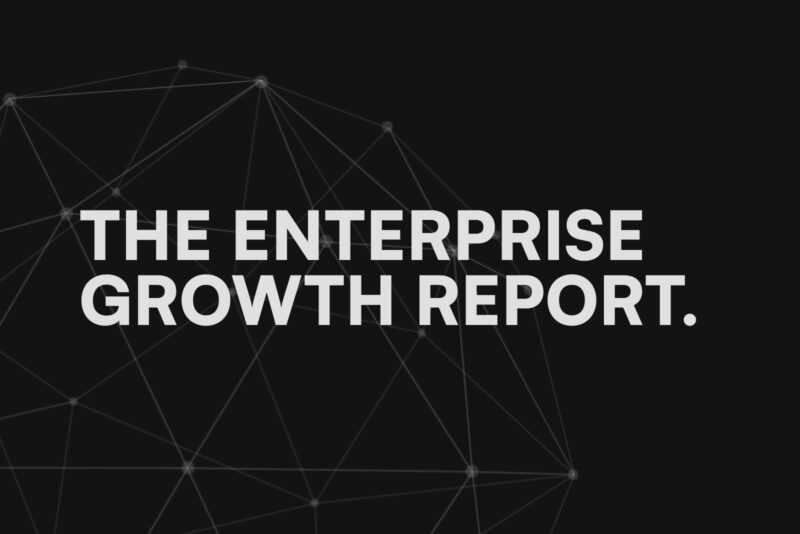
We’re unpacking the goals, challenges and opportunities awaiting business and marketing leaders over the next 12 months. Get insights into your peers’ thinking – and get ahead of the curve.
Read moreWhether your business is in the early stages of AI adoption or already well into its journey, this report is intended to clarify your optimal path forward. With the right foundations, AI dramatically amplifies the power of your enterprise’s data, processes, technology and people. But knowing exactly how, where and when to deploy it demands a strong foundational understanding of its capabilities, limitations and inherent opportunities. We’ve cut through the noise surrounding AI right now to provide just that.
of respondents to our Enterprise Growth Report survey want to integrate and automate technology and data. AI is the answer.
say they want to improve team capabilities. AI can help.
say they want to improve customer experience, engagement and loyalty. AI can help.
Artificial intelligence – AI – is the most talked-about and buzzed-over technology of the moment. No longer the preserve of data scientists, the subject of AI has entirely entered the mainstream. With news outlets and social media channels awash with advice and opinions regarding this most divisive of technologies, misinformation and misunderstandings are, predictably, spreading far and wide.
Within the global business community, some voices are hailing AI as a miraculous panacea for all their growth and efficiency woes; others decry AI as an unstoppable force designed to crush human creativity and decimate workforces while creating serious data security issues.
With emotions running high, it can be difficult for business and marketing leaders to discern the basic facts around AI: what it’s capable of, what it isn’t capable of, and how best to put it to use. This report aims to clarify this foundational information.
Firstly, what is AI?
AI is a computer system that can perform tasks that typically require human intelligence. AI development involves the creation of intelligent machines that can learn, reason, and make decisions – mimicking human cognitive abilities.
AI systems are comprised of three elements:
1. Data
AI systems rely on vast amounts of data to learn and improve their performance. This data can be structured – i.e. organized in a well-defined format – or unstructured – e.g. text, images, or audio
AI uses this data to identify patterns, gain insights and make predictions. While we have seen a prevalence of AI tools using publicly available data, the real advantage comes when this is blended with company owned data creating your own IP.
2. Algorithms
An AI system’s algorithms are the instructions that guide it to perform specific tasks or make decisions.
These algorithms analyze data, extract valuable information, and transform it into actionable intelligence.
3. Computational power
AI requires a great deal of computational power to process and analyze large datasets efficiently. Recent advances in hardware technologies – such as high-performance processors – have significantly boosted AI capabilities, and made the systems more widespread and accessible.
AI comes in two distinct forms:
Narrow AI
Also known, somewhat unflatteringly, as ‘weak AI’, narrow AI is the only form of AI currently available. ChatGPT, Midjourney, voice assistants, self-driving cars, search engines – these are all examples of narrow AI.
Narrow AI focuses on performing specific tasks within a limited domain. Narrow AI excels at these specific tasks, but lacks the broader understanding and versatility of true human intelligence.
General AI
Also known as ‘strong AI’, general AI can think, learn, and understand the world like we humans do. However, AI operating at this level remains largely hypothetical, and is yet to be fully realized. Some computer scientists believe it is impossible to achieve; others, that it is imminent.
General AI aims to be versatile across different tasks, just as humans are. It would have the ability to learn from various experiences, adapt to new situations, and solve problems creatively – all things that narrow AI cannot do.
Achieving first-mover advantage with AI.
By being one of the early adopters of AI, your business can gain a first-mover advantage:
AI adoption: where it stands now, where it goes next
Bluprintx spoke to 200 senior figures – marketing directors, marketing ops, creative ops and executives – from a breadth of enterprises. We asked them about their current and future plans for AI adoption.
As the results below show, AI is a fast-moving area, with all but a small minority of enterprises having little to no interest in it.
Are you using AI to assist with your marketing activity?
You can learn how business and marketing leaders view the ongoing adoption of AI by reading The Enterprise Growth Report.
of respondents to our Enterprise Growth Report survey are already using AI for marketing-content production.
say they have plans to use AI for content production in the future.
say they have no plans to use AI for content production.
Creating high-quality marketing that truly resonates with a target audience can be a costly and time-consuming process. The journey from ideation to realization is likely to involve multiple departments, disciplines and decision-makers, with any single task along the way having the potential to throw a spanner in the works.
In order to simplify and accelerate their workflows, many marketing departments are now deploying AI to create efficiencies and automate repeatable, resource-heavy tasks.
In our survey of 200 marketing and business leaders for our Enterprise Growth Report, the largest cohort of respondents – 44% – tell us they are already using AI for content production.
36% say they are planning to introduce AI for content production at some point in the next 12 months, while 14% say they are considering it for in the future.
Here are some of the key ways AI is being put to use in marketing workflows.
of respondents to our Enterprise Growth Report survey are already using AI to improve customer service.
say they have plans to use AI to improve customer service in the future.
say they have no plans to use AI to improve customer service.
As part of our survey of 200 marketing and business leaders for our Enterprise Growth Report, interviewees were asked “Which of the following statements apply to your company?” In all, 13 options were given, with respondents free to select as many as they felt applied to their business.
Among marketing leaders, the most popular statement – selected by 49% of respondents – was “Our business needs to improve customer experience, engagement and loyalty”.
Clearly, upgrading the customer experience is a leading priority for enterprises over the coming months. By deploying AI to help with this goal, businesses can make major improvements – effectively, rapidly, and at scale.
Real-time personalization
AI enables businesses to personalize customer interactions at scale. By analyzing customer data, AI algorithms can understand individual preferences, purchase history, and browsing behavior. This information can be used to deliver personalized recommendations, tailored offers and targeted communication. AI can suggest relevant products based on a customer’s previous purchases, or provide them with personalized product-usage tips.
AI algorithms can also analyze customer behavior on a website or app in real-time, and dynamically adapt the content displayed. This helps create a sense of relevance and responsiveness, enhancing customer engagement and satisfaction.
Chatbots and virtual assistants
AI-powered chatbots and virtual assistants are increasingly being used to handle customer inquiries and provide instant, 24/7 support. Fully automated, these systems can engage in real-time conversations, understand customer queries, and deliver accurate responses.
By leveraging natural language processing, chatbots can assist with common questions, provide product information, and guide customers through troubleshooting processes. This allows businesses to provide 24/7 support, improve response times, and enhance customer satisfaction.
Sentiment analysis
AI can analyze customer feedback and sentiment across channels such as social media, emails or surveys, assessing the opinions and satisfaction levels expressed by customers.
This allows businesses to gain valuable insights into customer perceptions, identify potential issues, and proactively address concerns. Sentiment analysis helps businesses improve their products, services and customer support based on honest, real-time feedback.
Predictive customer support
AI can help predict and prevent customer issues before they occur. By analyzing historical data, AI can identify patterns and trends that indicate potential problems. This allows businesses to take proactive measures to prevent issues or provide preemptive support.
For example: AI can predict delivery delays, and proactively make customers aware in advance so that they’re not expectantly awaiting a delivery. This, in turn, enhances the customer experience, engendering loyalty and brand advocacy.
of respondents to our Enterprise Growth Report survey are already using AI to improve customer insights.
say they have plans to use AI to improve customer insights in the future.
say they have no plans to use AI to improve customer insights.
The vast majority of the 200 marketing and business leaders we spoke to for our Enterprise Growth Report are either using, or planning to use, AI to get the most from their customer data.
Here are the key ways they’re doing – or plan to do – just that.
Data gathering
AI can automate the process of collecting customer data from various sources. AI algorithms can crawl websites, extract information from online forms, or scrape social media platforms to gather relevant data about customers.
AI-powered tools can also integrate with customer relationship management (CRM) systems, e-commerce platforms, or loyalty programs to capture and consolidate data in a centralized manner.
Data cleaning
AI can help clean and organize customer data to ensure its accuracy and quality. AI can detect and correct errors, standardize formats, and remove duplicates or irrelevant information.
Additionally, AI will continuously learn from its own data-cleaning process, and improve its accuracy over time. This helps enterprises maintain a clean and reliable database for analysis.
Data integration
By integrating data from across different sources and formats, AI can create a unified view of the customer. AI algorithms can, for example, merge data from CRM systems, website analytics, social media platforms and other sources into a single, cohesive dataset.
Such integrations allow businesses to gain a better understanding of customers’ interactions, behaviors and preferences.
Data analysis
AI algorithms can analyze vast amounts of customer data to identify patterns, trends, and insights. AI can uncover correlations, segment customers into specific groups, and make predictions about future behavior.
This helps businesses gain actionable insights to shape decision-making, such as identifying target audience segments, improving product offerings and optimizing marketing campaigns
Personalization and recommendation
As touched upon above in ‘Using AI to improve customer experience’, AI can leverage customer data to deliver personalized recommendations and experiences.
By analyzing individual preferences, purchase history, and browsing behavior, AI can suggest relevant products, content or offers to each customer. This personalization enhances customer engagement and increases the likelihood of conversion.

Ryan is responsible for establishing and supporting a global network of next generation consultants to design and deliver growth for some of the world’s largest organizations.
Meet the team
Share this report